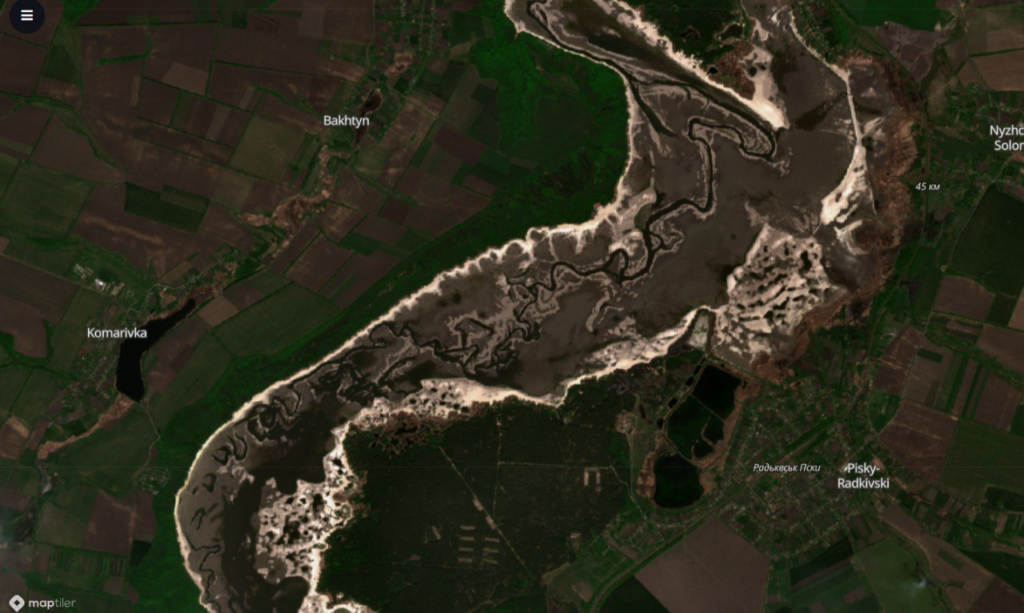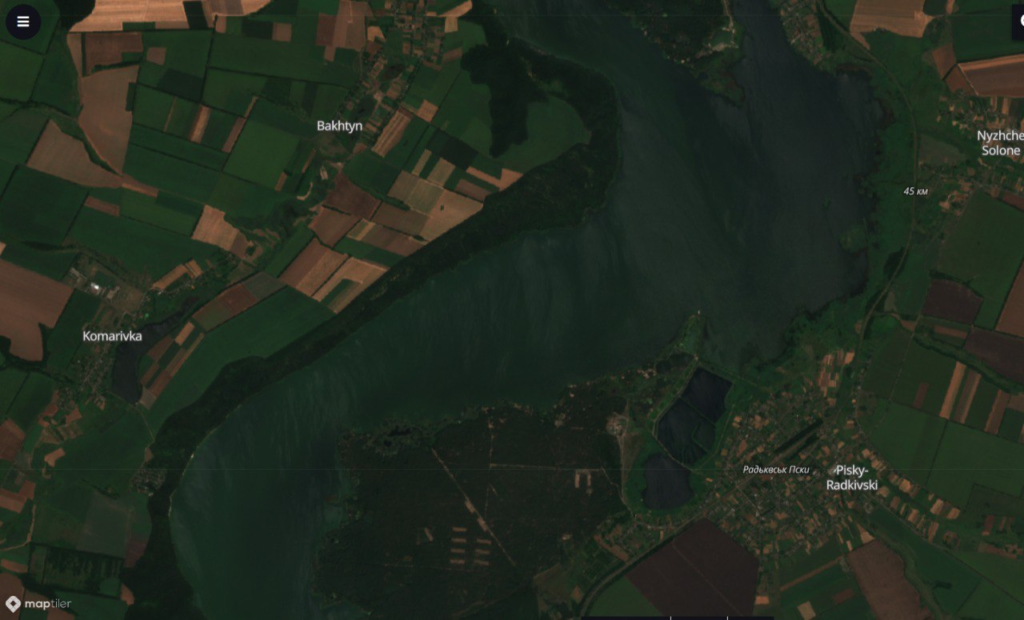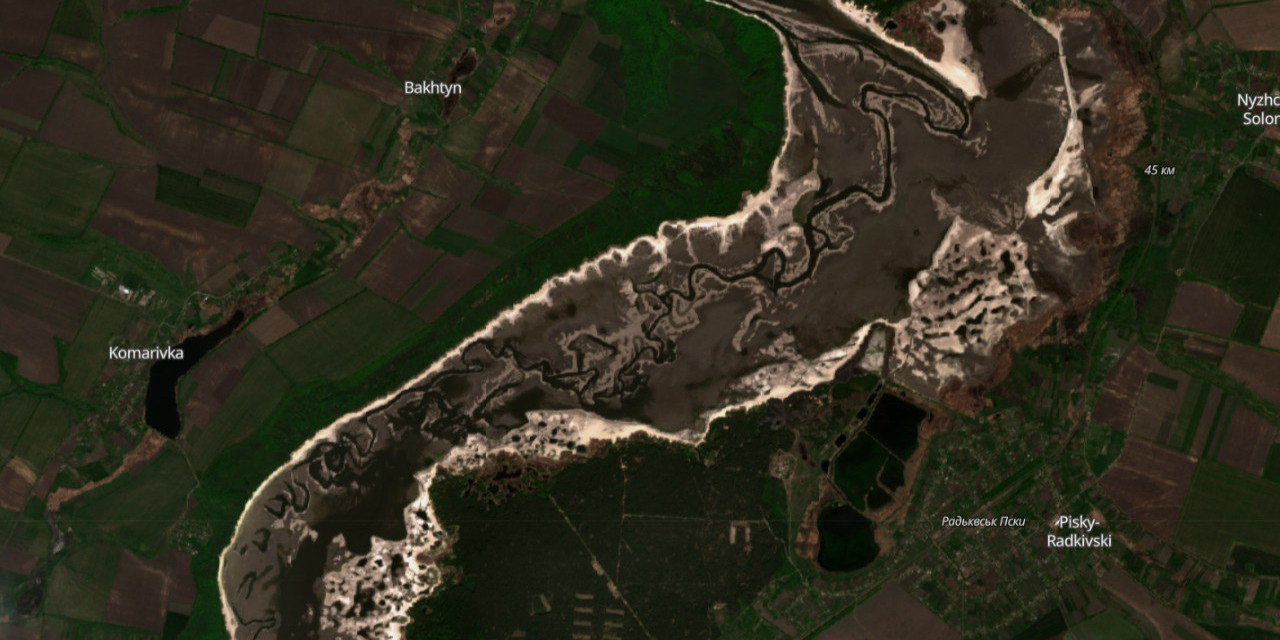One of the biggest changes in the environment caused by the russian-Ukrainian war was the destruction of one of the gates of the Oskil Reservoir in the Kharkiv region on April 2. About 355,500,000 cubic meters of water were rapidly released from the reservoir, causing the level of the Seversky Dinets River to rise and exposing about 9,000 hectares of silted bottom.
The rising water level in the Seversky Donets River, into which the Oskil flows, has helped to stop the advance of russian troops, who are still unable to cross the largest river in eastern Ukraine as planned. But in addition to short-term tactical advantages that are important for the protection of our state, there are long-term environmental consequences that are not so clear. Oskil Reservoir was created to regulate the water level in the Seversky Donets-Donbas canal (maintaining water content in summer, when the Seversky Donets River flows). That is, this reservoir is directly related to the water supply of the vast majority of the population of Donetsk and Luhansk regions. By the way, the final destination of the canal is Mariupol.
Thus, the stability of the further operation of the canal and water supply in the Donbass region is under threat – this is the main perspective from which this issue is considered by public authorities. Water supply in the Donetsk region is currently a matter of particular concern not only for the Donbass Water Company, but also for the United Nations World Health Organization. Millions of Ukrainians are deprived of drinking water, including Ukrainian citizens of the temporarily occupied territories of Donetsk and Luhansk regions.
However, it is the environmental consequences of the de facto cessation of the Oskil Reservoir that seem to worry few.
The age of the Oskil Reservoir is respectable – in 2022 it will be 65 years old. It is the largest reservoir in the Left Bank of Ukraine; eighth in surface area and total volume in the country as a whole (122.6 square km and 0.474 square km, respectively). However, despite its solid “dimensions” 33.5% of the area of the water mirror – shallow water, which, on the one hand, are favorable for fish spawning, and on the other – a place where siltation progresses. The average amount of sediment is from 0.5 meters in the lowlands of the reservoir to 1 meter in its upper reaches. Therefore, the water reservoir is swampy, has a high phosphorus content, low transparency and mediocre water quality (4th grade: limited suitability). In such conditions, cases of fish suffocation are not uncommon. However, people are forced to use the water supply system,

Bare landscapes of the reservoir bottom as of the end of May 2022, next photo- a year ago
which has existed for 65 years. If we take into account that the pumping units on the Seversky Donets-Donbas canal have also reached the end of their service life during all this time [1], perhaps the leakage of the Oskil Reservoir is a good opportunity to modernize the Donbass water supply system and give nature what it deserves. – natural floodplain of the river Oskil. By the way, the natural landscapes of the floodplain are perfectly preserved under the waters of the former reservoir and are clearly visible even from space.

To understand what has happened in terms of wildlife, it is necessary to understand what changes have taken place:
– on the one hand, the vast majority of water has leaked, a significant area of the bottom of the reservoir is exposed and is subject to wind erosion. The vegetation of the shores of the former Oskil Reservoir has lost its usual hydrological regime and is unlikely to continue to exist as before. This also applies to rare species, such as thin mowers, etc. Shallow waters were a place of feeding and nesting for a large number of waterfowl, including rare ones. All living organisms inhabiting the thick layer of now-exposed silt will now perish and this will cause a separate layer of problems. Most of the young fish and the fish population as a whole have been swept downstream, and there is not enough space to restore the former populations.
– on the other hand, the dam is not completely destroyed. Therefore, the flow of the river has not been restored and the chances of fish returning to spawning and free movement past the dam have not been formed.
Therefore, the incomplete destruction of the dam led to the destruction of temporary ecosystems formed on the site of the artificial reservoir, but did not create conditions for the natural restoration of the rheophilic ecosystem – a natural unregulated channel with running water.
So, after the war, we will be at a crossroads. One way is to repair the dam, return the water to a standing state and transport it for another half a century hundreds of kilometers to the south, while consuming electricity and, most importantly, human resources, which will be involved in repeated repairs of such water supply. Or allow nature to populate the Oskil floodplain with grasslands, which will restore the meadow landscape of the left, flat bank of the river and save the right, high bank from erosion. If such a decision is to be made, and it will be the most desirable from the point of view of wildlife, the flow of the river should be restored by dismantling the reservoir dam.
Option №1. Return the reservoir to its former state with the restoration of Oskil Hydroelectric power station capacity
It takes time to fill the reservoir. How long this process will take will depend on the hydrological conditions. For example, the first full-fledged filling of the Oskil Reservoir to the normal support level lasted from 1958 to 1977. No matter how long it takes to refill it, it will not go unnoticed for the Oskol river, its floodplain, flora and fauna downstream. In the part of the current below the dam, shallowing and overgrowing of the bottom by pioneer plants will probably take place. After all, the river sediments will be delayed by the dam, the transparency of the water below it will increase, where the Sinichynsky landscape reserve is located. The purpose of which is to preserve the natural part of the Oskil riverbed, coastal, aquatic ecosystems and rare species of animals and plants. The blockage of the river or even a significant reduction in runoff will be a direct destruction of the natural value of the reserve.
Restoration of the reservoir will mean that in the following years, after its replenishment, it will be possible to replenish the Seversky Donets-Donbas canal, and also to produce about 11 GW h / year of electricity at the Oskil Hydroelectric power station. But this capacity is actually equal to the average annual generation of one Vestas windmill, of which at least 500 are installed in various regions of southern and eastern Ukraine. However, the amount of electricity produced is dimming compared to that needed to pump water at the four pumping stations of the Seversky Donets-Donbas canal. According to the data of 2021 Municipal Enterprise “Water of Donbass”, the share of electricity consumption in the total cost of water supply reached 41% [2]. We can assume that when replacing the equipment of at least several of the 64 water pumping stations with energy-saving ones, the amount of potentially produced energy of Oskil Hydroelectric power station is leveled, as much more electricity is needed to maintain the canal than Hydroelectric power station produce. Donetsk region is one of the least water-supplied regions of Ukraine. Therefore, with the resumption of the reservoir, the necessary water discharges will be carried out, with a volume of about 50 million m³ for the needs of the Seversky Donets-Donbas canal (the main volume of water intake was for industry). But it affects not only cubic millions of water, but also the percentage of its loss during transportation by canal, which is 65-69% [2]. We return again to the question of the need for modernization.
Due to the large area of shallow water and stagnant regime, the water in the Oskil Reservoir will constantly “bloom”, and in the conditions of long-term climate forecasts, this problem will worsen. According to hydrobiological measurements in 2016, the number of phytoplankton in the water sample exceeded 100 cells / cm³. The period of “blooming” of blue-green algae before the accident on the dam was quite long due to abnormally high temperatures of air and water. This story will be repeated if the reservoir is refilled. Then it will not be recommended to rest on the coast or fish. If there is something to catch in the reservoir: the eutrophication of the fish dies from suffocation, and in the limited period in early summer (especially during the emergency descent of the reservoir) fry are not able to survive. The figures speak for themselves: if in 2017 the actual catch of fish in the reservoir was 13.61 t / year (with the approved catch limit of 19.58 t / year), in 2020 it decreased almost twice, to 6,076 t / year. The climate is also warming for shallow water bodies, such as the Oskil Reservoir, which leads to negative consequences that can be eliminated by restoring the full flow of the river. Especially given the fact that the efficiency (efficiency) of the reservoir after the possible resumption of the reservoir is quite low. If the restoration path is chosen, it will be the restoration of an inefficient, environmentally problematic and economically unprofitable structure.
Option №2. Finally dismantle the dam of the Oskil Reservoir and restore the natural course and floodplain of the Oskil River
The practice of getting rid of old and small / non-functional dams has long been acceptable in the EU and the US and is actively spreading today. 2021 was a record year – 239 abandoned or dilapidated dams were dismantled in the EU; for each of them a thorough study of the pre- and post-conditions of their decommissioning was conducted.
Restoring the flow of Oskol solves several problematic issues in the region, highlighted in the report on the state of the environment in the Donetsk region in 2019 [3]. It states that “According to the feasibility study “Improvement of the hydrological regime and improvement of the ecological condition of the Seversky Donets River in Kharkiv, Donetsk and Luhansk regions”, the coefficient of runoff regulation is 95% on over-regulation”. One of the options to solve the problem was to “determine the feasibility of operation of hydraulic structures in reservoirs.” This option is absolutely appropriate in the case of the Oskil Reservoir.
Let’s imagine what will happen if, after expert analysis, further operation of the reservoir and hydroelectric power plant is deemed inexpedient (we have all the grounds for this, set out in a brief overview of the option to return to work above), and the dam – dismantled. It is very important that such a solution aimed at solving environmental problems is truly environmentally friendly. For example, in order to prevent the reservoir from descending, communities will begin to develop previously inaccessible “land resources” by plowing or building up areas free of water. The bottom of the former reservoir will remain bare only temporarily, animals.
First of all, the restoration of the natural runoff of Oskol will give a chance to return to their habitat for many species of fish, for the existence of which requires running water and an unblocked riverbed. They will be a good forage base for birds that nested in the reed thickets of the former reservoir, or those that will return to the restored floodplain landscapes. Among the species protected by the Red Book of Ukraine and in need of a flowing riverbed.
Unfortunately, the detrimental effects of the reservoir have affected not only wildlife. The right, high bank of the river, covered with picturesque Cretaceous outcrops, has suffered significant damage from storm surges up to 1 m in height during the reservoir’s existence. After the return of water flow, its quality will increase – the amount of phosphates will be regulated naturally. This will eliminate the problem of eutrophication, because such organic impurities as phosphates (the amount of which in the samples from the reservoir was much higher than normal) served as a kind of fertilizer for the growth of photosynthetic algae.
If the economic profitability of the reservoir’s water resources and generated energy at Oskil Hydroelectric power station capacity can be questioned (details are given in “Option №1. Restore the reservoir”), the water-regulating function of the dam remains relevant. The water in Oskil rises to 5 m (on average) during spring floods, which should not threaten flooding of coastal villages. However, no one is safe from abnormal floods, especially in global warming. Examining the experience of the state of California in the United States, we can say that it is natural floodplains, rather than blocking the channel, is a sustainable solution to climate change. After the river is liberated from the dam, new wastewater treatment and drainage systems are being designed. There are several options: build rainwater basins, or, in the case of herbaceous plants on the site of a former reservoir, build filtration buffer strips. This approach is reformational for Ukraine and has not been used before, but the United States and Europe have a sufficient number of successfully completed projects and people willing to share their experiences.
Separately about the Kharkiv region. Kharkiv region is currently last on the list in terms of the rate of creation of new nature reserve fund and one of the last in their number: Kharkiv region reserve – 2.38%, although by 2021 this figure was to increase to 9% (Resolution of the Cabinet of Ministers of December 20, 2017 p. № 1089). The area of the NRF of Kharkiv region can be replenished at the expense of the reservoir-free territories. However, part of the reservoir is already included in the area of some environmental facilities. 4,000 hectares are protected in the Krasnooskilsky Regional Landscape Park (approximately 30% of the total area of the reservoir); 10,082.00 ha (82% of the reservoir area) belongs to the Emerald Network of Europe (Chervonooskilsky Reservoir, UA0000104). However, the emerald territories do not have a real protection status yet and traditionally they are protected by declaring the territories of the nature reserve fund.
The possible restoration of the natural course of the Oskil River is the first conscious step to free rivers from dams in Ukraine. With it, we can assert our environmentally conscious position as the largest country in Europe, deepen ties and share experiences with our friendly countries. The decision to dismantle the dam will help speed up decisions on the modernization of water supply systems in Donbass. But in addition to the undoubtedly important communication and economic functions, getting rid of the dam first of all means returning dozens of representatives of flora and fauna to their natural habitat. This is a step of man towards nature.
Valeria Kolodezhna, Oleksiy Vasyliuk
[2] https://mrpl.city/blogs/view/virishuemo-pitannya-zabezpechennya-donechchini-vodoyu







